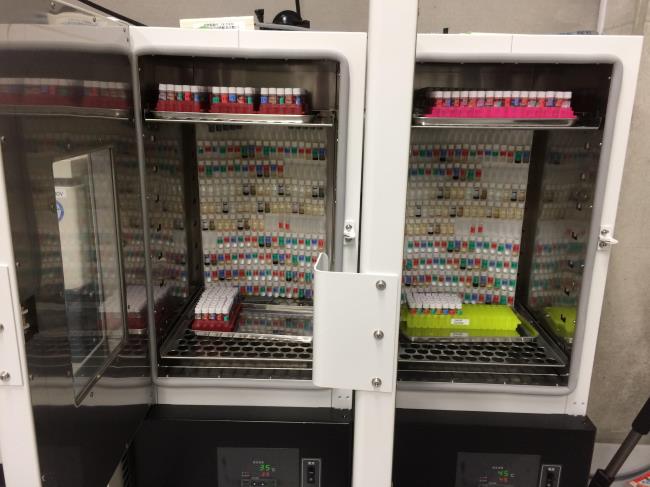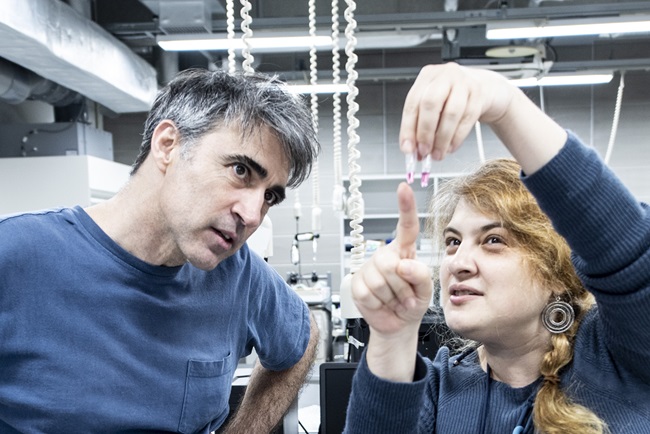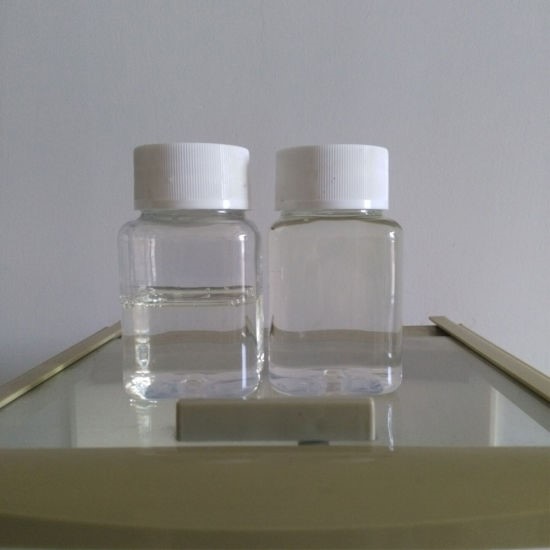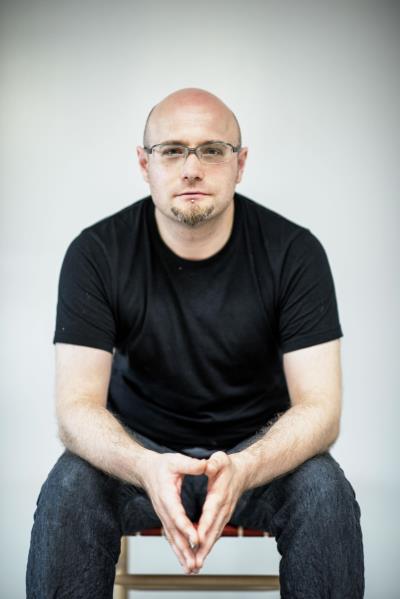
An array of vials that have been given months to produce chemical reactions. Given these long periods of time, some appear to be producing their own catalysts, an important part of the origins of life story. (Marc Kaufman)
Over the centuries, virtually all laboratory chemical experiments have been started, allowed to run and finished in two days or less. This approach has resulted in untold successes, but has also virtually ignored the kind of chemistry that may have led to the origins of life on Earth.
That chemistry might have been slow-moving, especially in very early times on Earth when catalysts to speed up prebiotic chemical and then biological reactions existed in rudimentary form, if at all. Efficient and highly specific catalysts are what make the modern world of biology work.
Given this set of scientific realities – 97 percent of chemistry experiments finished within two days, according to a 2014 paper in Chemical Society Reviews – researchers at ELSI decided five years ago to begin an experiment that would continue for months or years to see what may have been missed by all the short and fast-paced studies of chemical reactions.
ELSI assistant professor Nathaniel Virgo, a specialist in artificial life, and ELSI associate professor Jim Cleaves, an organic geochemist, designed and built a very low-tech display board holding 200 small vials of a wide variety of simple inorganic chemicals in varied combinations. The vials were kept at room temperature – heat generally speeds up chemical reactions – and then they waited.
What they were looking for were changes in color inside the vials, and for several months nothing changed. But after three or four months, most intriguingly some did begin to change color. And as Cleaves described it, within a half-year about 5 to 10 percent of the vials had lit up with new colors.
“We had a camera on the vials and saw nothing, nothing, nothing and then boom – all kinds of color changes started happening,” Cleaves said. “Colors were flickering all over the array… This is not what you usually observe when you conduct these kinds of experiments for short periods of time.”

Jim Cleaves and Irena Mamajanov in the ELSI lab in Room B11, examining the results of their long-term auto-catalysis experiment. (Nerissa Escanlar)
Four years later, variations on these experiments are on-going and the researchers – now including ELSI professor Irena Mamajanov – are increasingly confident that something potentially quite important is happening. Those sudden changes in color after months of apparent stability suggest that interesting chemical reactions are occurring.
If delayed chemical reactions are indeed suddenly taking place, the researchers say they may well be witnessing the all-important phenomenon of autocatalysis – when a single chemical reaction produces a catalyst for the same or a coupled reaction. This process is widely held to have been essential for the prebiotic Earth to, over eons, transform into a fast-paced biological world from a slow-moving chemical and geological one. Indeed, autocatalysis is something of a holy grail in origins of life research.
The team has continued to analyze the results and has worked to rule out biological contaminants as a source of the changes. So far, no microbes have been found.
19th century France’s Louis Pasteur claimed to have results showing prebiotic autocatalysis, but they turned out to be caused by microbes or other chemical processes. Given this history, the ELSI team is moving ahead carefully with its analysis and publication of results. With so many potentially confounding factors – and in keeping with the logic of slow chemistry – they think it’s important to be exhaustive with the experiment and analysis.

The compound formamide will quickly turn black in water when heated at a high temperature. However, it also turned black after six months at room temperature in the ELSI array – a possible example of a highly unusual reaction producing a chemical catalyst that suddenly sped up color change. (Haihang Industry Co., Ltd.)
Nonetheless, some of the results are striking. For instance, Cleaves described the unusual reaction that occurred in a vial with formamide and water among other reagents. Formamide is a clear liquid which is fully mixable with water and has an ammonia-like odor. It is a chemical feedstock for the manufacture of various pharmaceuticals, herbicides, pesticides, and for the manufacture of hydrogen cyanide (HCN).
It can be produced by combining HCN (a compound ubiquitous in the cosmos) with water. To return the formamide to hydrogen cyanide and other chemicals, it normally takes heating up to 120 degrees Celsius (266 degrees F) or higher. In the process, the contents of the vial would turn from brown to black.
But in their array, six months in the ELSI lab saw the formamide vial suddenly turn black. This happened at room temperature and so was a most unusual chemical reaction.
“We knew that the formamide had the potential to react – that wasn’t surprising,” Cleaves said. “But because we were at room temperature rather than a high temperature, it was definitely a surprising change. Heating speeds the reaction, but here the same thing happened over months at a much lower temperature.
“Was this an autocatalytic reaction? It could have been.”
Other color changes that occurred over time similarly could have been the result of chemical reactions producing their own catalysts. And in some cases, when a sample of a color-changed compound was placed in a vial with the original test chemicals, those original chemicals changed color faster with what seemed to be a newly produced catalyst, and then faster still with each iteration.
Nicholas Guttenberg, a computational physicist and research scientist at ELSI who works on models of autocatalysis, said of the (tentative) results from the downstairs array, "In my opinion, this is the most significant research to fundamentally advance the origins of life field that has come out of ELSI so far."

Nathaniel Virgo, ELSI specially appointed assistant professor, is an Artificial Life and origins of life theorist who first came up with the idea of a slow-chemistry experiment that might produce autocatalysis. He then went to experimentalist Jim Cleaves to design the study that has been turning out surprises since 2015. (Nerissa Escanlar)
That these three scientists have collaborated on this experiment is very much in keeping with the kind of research they all are involved with.
Virgo is a theorist who focuses on cutting edge topics such as the evolution of evolution, autocatalysis and complex systems, with an emphasis of how order emerged from the chemical chaos of early Earth. He looks for tell-tale patterns in phenomena and environments, trying to find the characteristics of life that have not been extensively explored.
A primary characteristic of biology is, of course, its ability to evolve. Some of Virgo’s drive to set up the slow chemistry array was to ask the question whether chemicals – like living entities – can, in effect, evolve as well.
“There ought to be a gray area between life and chemistry, since life emerged from chemistry,” Virgo said. “Maybe if a chemical system gets a little way into the gray, then it can go further and further toward biology, unless another system is more robust and prevails. We think autocatalysis has to play a significant role in this process.”
Cleaves is an experimentalist in the tradition of his former adviser Stanley Miller – who theorized and then conducted the iconic experiment that proved amino acids and other important-for-life compounds could be formed by electrically sparking a collection of compounds otherwise not associated with life. The Miller-Urey experiment opened a pathway into understanding how life could have emerged over time on the early, abiotic Earth.
Mamajanov has been a pioneer in the field of “messy chemistry,” which stands as an alternative to the origins-of-life schools that look for a single or well-defined pathway from a world without biology to one with it.

Cleaves and Mamajanov hamming it up in the Agora. (Nerissa Escanlar)
Wouldn’t it be more logical, Mamajanov has asked for some years now, for the origins of life to be found in some of the complex systems on early Earth with vast numbers of components; systems that over the eons developed order and function in the midst – and to some extent because of – all the disorder around them?
So all three of them are focused on the origins of life question from the general perspective of how Earth’s chemicals came to self-organize, self-catalyze, and ultimately self-replicate in the disordered geochemical world of the early environment. Rather than brushing aside the confounding aspects that so often come with synthetic life and origins of life experiments, they look to great prebiotic chemical complexity as a potential source of life rather than as an obstacle to it.
Given these views, watching how a relatively random collection of compounds potentially changes over long periods of time – long by human scientific measures, that is – is right up their alley.
“I like to think about origins of life chemistry in terms of trying to reinvent the origins of life,” Mamajanov said. “So let’s come up with an evolvable system that is not biological. And in order to come up with an evolvable system you need a few parameters – you want selectivity, you want replication, and heredity. If we can show autocatalysis, then this is in a way replication and so we can solve one of the problems.”
If autocatalytic chemistry continues and amplifies itself, she said, then it will consume the nutrients present and in that way self-select. And then perhaps on to heredity.
“So this is potentially a first step in assembling an evolvable chemical system,” she said.
In setting up new vial arrays, monitoring them and analyzing them via mass spectrometer, the three researchers have had important help from colleagues including former ELSI Origins Network fellow Ric Gillams and lab technicians Melina Caudan and Kumiko Nishiuchi.
The plan now is to keep the experiment going, identifying and concentrating the solutions that are changing over time, and working to analyze what precisely might be going on.
------
Marc Kaufman has written books on astrobiology and Mars, has been a longtime reporter at The Washington Post and The Philadelphia Inquirer, and writes the NASA-supported online column Many Worlds (www.manyworlds.space) He has also had the good fortune to visit and work at ELSI numerous times and he wrote "ELSI RISING" -- the story of ELSI's origins and evolution -- in 2017.
